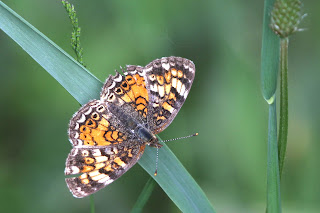Take for instance the Phycoides group (i.e., Northern and Pearl Crescent). There is such a great degree of variation in both sexes both in colouring and size that it becomes nearly impossible to separate them. According to a friend, James Holdsworth, opinions range from some questioning whether they are even two species to some who believe that there are up to four species!
We have also discovered how much fun they are to photograph! They have so many beautiful, intricate patterns and colours.
 |
| American Lady (Vanessa virginiensis) - view of undersides |
Often one of the keys to identifying a butterfly is get a good view of the underside hindwings and forewings. In the case of the Polygonia group, this holds true. The uppersides can be quite variable in Grey Comma (Polygonia progne), Eastern Comma (Polygonia comma) and Question Mark (Polygonia interrogationis) for example, making them confusing to identify just from views of the uppersides. The undersides of these three species provide clues that distinguish them from each other. Below is a photo of a Question Mark, which has a small sideways silver "?" mark on the underside of the hindwing. The Eastern Comma has a silver "," on the underside of the hindwing where the comma is enlarged at both ends, whereas the Grey Comma has a silver "," similar to the Eastern Comma, but the comma tends to taper at both ends instead.
Stay tuned for more entries on the fascinating world of Lepidoptera in the future!




No comments:
Post a Comment